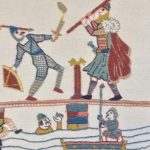 Mysteries
Mysteries  Mysteries
Mysteries  History
History 10 Surprising Stories About the Texas Rangers
 Humans
Humans 10 Philosophers Who Were Driven Mad by Their Own Theories
 Miscellaneous
Miscellaneous 10 Video-Game-Worthy Weapons and Armors from History
 Weird Stuff
Weird Stuff 10 Psychics Who Accurately Predicted Wartime Events
 The Arts
The Arts 10 Pieces of Art Inspired by a Broken Heart
 Health
Health 10 Science Fiction-Sounding New Medical Treatments
 History
History 10 Surprising Facts About the Father of Submarine Warfare
 Space
Space Ten Astonishing New Insights into Alien Worlds
 Weird Stuff
Weird Stuff 10 Bizarre Summer Solstice Rituals Still Practiced Today
 Mysteries
Mysteries Top 10 Haunting Facts About the Ghost Ship MV Alta
 History
History 10 Surprising Stories About the Texas Rangers
 Humans
Humans 10 Philosophers Who Were Driven Mad by Their Own Theories
Who's Behind Listverse?

Jamie Frater
Head Editor
Jamie founded Listverse due to an insatiable desire to share fascinating, obscure, and bizarre facts. He has been a guest speaker on numerous national radio and television stations and is a five time published author.
More About Us Miscellaneous
Miscellaneous 10 Video-Game-Worthy Weapons and Armors from History
 Weird Stuff
Weird Stuff 10 Psychics Who Accurately Predicted Wartime Events
 The Arts
The Arts 10 Pieces of Art Inspired by a Broken Heart
 Health
Health 10 Science Fiction-Sounding New Medical Treatments
 History
History 10 Surprising Facts About the Father of Submarine Warfare
 Space
Space Ten Astonishing New Insights into Alien Worlds
 Weird Stuff
Weird Stuff 10 Bizarre Summer Solstice Rituals Still Practiced Today
10 Facts about America’s Forgotten Invasion of Mexico
We cover quite a few wars, don’t we? Surely, you’ve read a thing or two (or a few dozen!) on World War I and World War II. America’s forays into Korea and Vietnam are much covered, too. And, of course, there’s the American Civil War in tow, along with a series of conflicts all over the world. But one war that is woefully under-covered by historians and amateur analysts alike is the Mexican-American War.
Beginning in 1846, the conflict started over a dispute about Mexican-held lands that would later become several of the U.S.’s important southwestern states. For many reasons, the Mexican-American War was one of the most significant events in American history. It was a training ground for future Civil War generals, for one. And it was one of the deadliest wars in American history, proportionally. Not to mention, the U.S. scooped up a considerable amount of its future territory after winning the thing in 1848!
But in spite of all those reasons, the Mexican-American War remains relatively forgotten by too many. So let’s change that today! In this list, we’ll go over ten fascinating facts about one of the most important—and most forgotten—wars in American history!
Related: Top 10 Chilling Civil War Stories
10 Sell or We’ll Invade
The U.S. didn’t initially want to invade Mexico. Instead, they were hoping to come away with some new western territory for their growing nation. So, in the 1840s, President James K. Polk offered up some cash in exchange for large swaths of what was then northern Mexico—including current American states like New Mexico, Arizona, and California.
Late in 1845, Polk sent diplomat John Slidell to the U.S.’s southern neighbor on a secret mission. Slidell was ostensibly there to solve an ongoing border dispute between the two countries. But behind the scenes, he had an offer for the Mexican government: $25 million in American cash in exchange for most of Mexico’s northern lands, including California.
The Mexicans balked at the offer, though. Polk was incensed at being rejected, so he ordered then-General Zachary Taylor to take 4,000 troops and occupy land in present-day Texas between the Nueces and Rio Grande rivers. That had been a region Mexico was claiming as its own at the time, and Polk wanted to push the issue a bit.
As he expected they would, the Mexicans sent their own troops into the disputed zone as well. Then, on April 25, 1846, the Mexican troops attacked a small patrol of American dragoons. With that, the war was begun. Less than three weeks later, on May 13, Congress overwhelmingly voted to authorize a war against Mexico.[1]
9 A Civil War Trial Run
Because of the timing of the Mexican-American War, it served as a trial run for many future Civil War generals. Of course, in 1846, few in the United States knew they’d be fighting internally just 15 years later. But that’s how history played out—and the men who led the charge down in Mexico would turn around soon enough and fight their own countrymen.
Those Mexican-American War generals included three future American presidents: Franklin Pierce, Ulysses S. Grant, and the aforementioned Zachary Taylor. In addition, other soon-to-be-famous Civil War figures fought in Mexico, too. That list included Stonewall Jackson, George Pickett, and none other than Robert E. Lee himself.
Lee, in fact, made his name as a military strategist in Mexico. He scouted desert landings and mountain passages ahead of American troop movements and figured out where the Mexican Army’s men were stationed. His scouting directly led to American victories at the Battles of Cerro Gordo and Contreras. After that, he was considered a made man by the American military brass—only for it all to blow up on them in 1861.[2]
8 Mexico’s Internal Strife
Mexican military leader Antonio Lopez de Santa Anna wasn’t exactly popular in America even before the war. Of course, that was because of his actions at the Battle of the Alamo a decade before in San Antonio. But Santa Anna used the Mexican-American conflict to solidify his hold on Mexico’s people, and he did it with the unlikeliest of allies: James K. Polk himself.
Santa Anna had been stuck living in exile in Cuba after a failed stint as a dictator ruling over all of a divided Mexico prior to the war. Seeing his opportunity to make a move to get back to his beloved homeland, he reached out to Polk just a few months after the Americans declared war in 1846. Santa Anna said he could personally negotiate peace between the two countries if only the Americans could ship him back there from Cuba in a naval blockade. Polk agreed and ordered the U.S. Navy to escort Santa Anna south of the border.
There was just one problem with the plan: Santa Anna didn’t keep his word. Upon landing on Mexico’s shores from his exile in Cuba, Santa Anna immediately double-crossed Polk and his northern enemies. He organized Mexican troops and started fighting off the invading Americans in the months after his arrival.
Polk was angered over it, but there was little he could do. After all, the Americans were already fighting in Mexico; now, they would simply have to fight against Santa Anna, too. He quickly reclaimed the Mexican presidency and ended up leading troops in all the major battles over the next two years.[3]
7 Honest Abe Hated the War
Abraham Lincoln absolutely hated the Mexican-American War—and he wasn’t the only one. In fact, the conflict in Mexico marked the first time a serious anti-war movement popped up in the U.S.. Political opponents of President Polk said the war was a shameless and brazen land grab.
Abolitionists pointed to the geography of the war’s contested areas and claimed Polk was simply invading Mexico in order to grab more slave states for Southern plantation owners. And the freshman congressman and soon-to-be-future president from Illinois let it be known on the record that he did not agree with the war’s goals or principles.
In an 1847 speech on the House floor, Lincoln demanded that Polk tell the world about the location of the “spot of soil” upon which the war’s first skirmish took place. That was important to Lincoln and other anti-war advocates because they felt Polk had unfairly invaded Mexican territory to provoke a conflict. Lincoln and others even introduced official resolutions asking Polk for this information and branding him a “coward” who was seeking “military glory.”
Lincoln became very well-known nationwide for his anti-war advocacy during the conflict. His official House resolutions became known by most and respected by many as “Spot Resolutions” on the war’s geographic starting point. In turn, it all helped Lincoln make a name for himself as a politician. His history was far from being written, of course. But to think it all started with Honest Abe’s hatred of what he felt was an unjust and damaging conflict…[4]
6 By Land? Nah, by Sea!
The Mexican-American War was notable for many reasons, including one you might have never considered: It hosted the Americans’ first-ever amphibious attack on a foreign power. Well over a century before the Navy Seals were ever a thing, General Winfield Scott invaded the Mexican city of Veracruz in March 1847. He did so by sea and opted to put together the U.S.’s first-ever amphibious assault to ensure victory. Scott’s plans called for a huge incursion: He ordered his Navy sailors to build out and fill surfboats with more than 10,000 American troops.
The troops were shuttled from the Gulf of Mexico onto the shore in sustained waves for hours. After nearly six hours of round trips, the surfboats had successfully landed all 10,000 men ashore. Veracruz’s garrison of soldiers was entirely outnumbered at that point, and the town put up a very tepid defense. Scott then set off on a 20-day siege of the area. Veracruz and the surrounding cities surrendered after being unable to mount an effective reply.
For Scott, his men then pushed inland. They went on to go through a six-month-long, 265-mile (426.5-kilometer) march into Mexico City. They fought other Mexican soldiers along the way and eventually reached the “Halls of Montezuma” in the country’s capital.
But it was the amphibious assault that made headlines as far as historians are concerned. In fact, it would be America’s largest water landing of troops for another one hundred years—until the infamous happenings of World War II.[5]
5 The Irish Helped… Mexico?!
During the middle of the Mexican-American War, a band of Irish-American immigrants defected from the American side and joined their enemies south of the border. The group of Irish-born men was known as St. Patrick’s Battalion, and they had been one of the U.S.’s most formidable fighting forces before deserting and joining up with Mexico.
The 200 men who made up the fighting force were Catholics, as were many of their brethren back home in Ireland. But once they’d gotten to the United States, they had quickly grown tired of anti-Catholic prejudice from the predominantly Protestant population. So when they saw they had an opportunity to fight for another group of Catholics—that is, the Mexican force—they cast their lot with their religious peers.
The leader of St. Patrick’s Battalion was a man named John Riley. He led the defectors to Santa Anna’s Mexican army. There, they became the formerly-exiled general’s esteemed artillery force. And for a while, they were very successful at what they did. The Irish defectors acquitted themselves well at the Battles of Buena Vista and Cerro Gordo. But an August 1847 fight at Churubusco led to virtually all of the unit being killed or captured.
The ones who were taken into custody by the Americans were later court-martialed by the U.S. Army, with more than four dozen executed and the rest whipped and branded with a “D” for “deserter.” It wasn’t all bad for the Irish soldiers, though.
Down in Mexico, they are still celebrated for their achievements on behalf of the nation. Known south of the border as the “San Patricios” still today, they are honored by modern Mexicans on every St. Patrick’s Day. That’s only fitting, we suppose, considering how Americans have fallen in love with Cinco De Mayo![6]
4 Mexican Legends Live On
Just like their unlikely Irish allies, other Mexican forces from the war are still honored in the modern age. Most notable among these was a group of men—and young boys—who fought for their country against the invading Americans at the Battle of Chapultepec. It was in that battle, just outside Mexico City in September of 1847, where American forces were blocked from invading the capital. Standing in their way was Chapultepec Castle—a historic and imposing fortress that doubled as Mexico’s version of West Point.
General Scott (yes, the same general who had just marched his men hundreds of miles inland from their amphibious landing in Veracruz) ordered his troops to storm the castle. He was hoping they would be able to climb up the impenetrable building’s stone facade with ladders they’d carried inland with them. The Americans had numbers there like they did in nearly every battle of the war. So when they began charging and climbing, most of the Mexicans within the castle withdrew to fight another day.
But not six teenage boys who had been students of the military academy. These six young cadets stayed at their posts and valiantly fought against the Americans until the very end of their young lives. According to Mexican military lore, when it was all coming down to the end for these outnumbered souls, one of the young cadets supposedly draped the Mexican flag around his body and jumped to his death off the top of the castle wall.
True or not, the myth has remained. Even today, Mexicans remember and honor the “hero children” of Chapultepec, and the nation has erected a monument to them in the heart of Mexico City.[7]
3 Treason or Treaty?
While the war may have started because of Polk’s trickery near the Rio Grande, it ended in an even more conniving fashion. By the middle of 1847, the war was inching toward a conclusion. And it seemed as though the United States had the upper hand—they were, after all, the more powerful and better-equipped army. But as the months went on, the finish line simply wouldn’t pop up. So, in late 1847, Polk sent a U.S. State Department assistant named Nicholas P. Trist to Mexico City. His job was to secure a peace treaty with Santa Anna and the rest of the Mexican leaders.
At first, negotiations proved very, very slow. By late November of that year, with no apparent progress having been made, Polk ordered Trist to return home at once. Trist didn’t follow the order, though. And while he didn’t commit outright treason, his direct disinclination to do as his president demanded was a jaw-dropping move—for then or now.
First, upon disobeying Polk’s order, Trist powered through a 65-page (!) letter back to Washington. In it, he laid out all the reasons why he believed he was on the verge of brokering a full peace accord. Then, he kept negotiating with the Mexicans, who were none the wiser to Trist’s daring move.
Back in the White House, Polk literally seethed at the affront. He publicly called Trist “destitute of principle” and vowed to fire him upon his return home to America. He moved immediately to remove Trist’s position from the State Department and his offices from the U.S. Army headquarters. That worked stateside, but Polk couldn’t stop the negotiations in Mexico City.
Trist carried on south of the border, and on February 2, 1848, the Treaty of Guadalupe Hidalgo was finalized. Polk reluctantly accepted the deal—he, too, wanted the war to be over—but he never forgot how Trist had so openly disobeyed him. And when the treaty broker returned to Washington weeks later, he was immediately fired.[8]
2 Far Too Many Killed
One of the most amazing forgotten parts of the Mexican-American War is that it had one of the highest casualty rates of any war fought by the United States. The U.S. didn’t lose a single major battle throughout the entire war, but they lost many, many men, relatively speaking. The numbers bear that out in stunning detail.
While driving south into Mexico, the Americans ultimately put 79,000 men into service over those two years. Of those soldiers, roughly 13,200 died while serving in the military incursion. That’s a death rate of just about 17%—and yes, if you’re curious, that does put the Mexican-American War as a more deadly conflict than both World War I and World War II.
Not all the deaths are quite what they seem, though. Just like what would happen in the Civil War 15 years after this one, the American deaths in the Mexican-American War were largely due to disease. Dysentery, smallpox, malaria, and yellow fever were all significant killers during the war. In fact, a higher percentage of U.S. troops died from those diseases and others than were killed in battle by Mexican forces.
Battlefield health care, hygiene, and disease management were all practically unheard of at the time, so those numbers do make some sense. It doesn’t lessen the tragic after-effects the deaths put on American families who lost loved ones, though. And the Americans weren’t the only ones mourning after the war, either. Historians today estimate that about 25,000 Mexican troops and civilians died during the vicious conflict within their borders.[9]
1 Shrinking Mexico
Casualty rates aside, the war proved to be a major boost for the eventual American push westward. After signing the Treaty of Guadalupe Hidalgo, the Americans were able to take over quite a bit of land in the now-former northern section of Mexico. The treaty called for the United States to pay Mexico $15 million. In exchange, the Americans received over 525,000 square miles (1.36 million square kilometers) of land. That’s an area larger than present-day Peru, and it all came in what was then the relatively unknown far west.
Today, that land makes up parts or all of several of the United States, including California, Nevada, Arizona, Utah, New Mexico, Colorado, Wyoming, Oklahoma, and southwestern Kansas.
As you may recall reading at the top of this list, Polk had initially offered $25 million in American money for most of those very same northern lands, including California. Mexico balked at that offer, the war kicked off, nearly 40,000 people died over almost two full years of conflict, and then Mexico still had to give up the land—for $10 million less than initially offered. Oops.[10]








